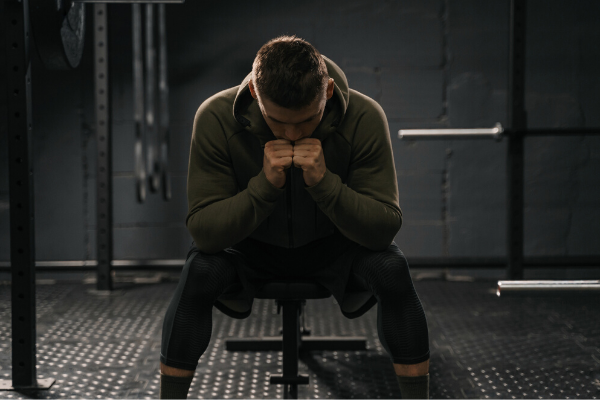The Recovery of Craig K.








Monday morning is a stressful time for many people. Anxiety about work or a depressed mood are not beneficial for anybody but they can be dangerous relapse triggers for people in recovery from addiction.
One way to deal with the Monday blues is to confront it head-on and make a virtue of it. Michael Arnold is the director of alumni and recovery support services at Harmony Foundation. She has found an engaging way to help people in recovery snap out of any dark moods they may be experiencing.
In May, Michael started a podcast called “Monday State of Mind” to give the recovery community a positive start into the workweek. Her sheer boundless enthusiasm alone will cheer up your Monday—or any other day for that matter. “I know the good that happens when I choose to be consciously aware of my state of mind,” explained the woman known as the “Hurricane of Happiness” in episode one. An alumna of Harmony herself, Michael continues to use the tools that were given to her while she was there as a client.
The fuel behind “Monday State of Mind” is her intense desire to “recover out loud” and in the process help others in the same situation. “ At Harmony, I get to help alumni implement the foundation they learned into their daily lives and help show them how to continue to take their power back by creating and living lives that are filled with continuous growth, meaningful connection, service, gratitude, and so much more.”
“Monday State of Mind” means to tackle thought-provoking questions that relate to recovery and how to apply the answers into the daily life of listeners. Michael aims to challenge listeners to ask themselves whether their state of mind is helping them catapult their week forward, or whether it is harming their week.
And when things don’t go your way, you just have to deal with it—appropriately. The week leading up to episode nine reminded Michael to keep it authentic when she realized that her request for listener questions had resulted in zero replies. In typical Michael Arnold fashion, she turned that Monday disappointment around and made it the topic of the episode that followed four episodes about humility after all.
At first, she got anxious and started blaming herself for this “failure.” Destructive, self-defeating thoughts showed up: “Why are you even doing this podcast?” and “No one is listening!” Then her ego chimed in: “Michael, you can’t admit that no one submitted questions. Just make some up!” But she felt fairly uneasy about making things up—she didn’t want to be a fraud. Instead, Michael called a friend who put her straight: “Michael, this is your opportunity to really show what you have been talking about. Your topics are happening to you. You have a great opportunity to be humble to the world and talk about it.”
Michael realized that “in order to change your state of mind you have to make tough decisions to grow. You have to be prepared to be a little uncomfortable.” She understood that she can’t expect listeners to be transparent, truthful, and vulnerable if she is not prepared to be so herself. After all, nobody is perfect and you can’t beat the Monday blues by faking it.
_____________________
Catch the podcast here: https://stage.harmonyfoundationinc.com/monday-state-of-mind/
Michael Arnold is the co-author of Drowning in Addiction: A Personal Guide to Recovery
Subscribe on any of these podcast platforms!
Apple Podcasts
Spotify
Google Podcasts
Stitcher

“Drug bust nets $762,000 in meth, heroin and more near Colorado Springs,” reported The Gazette in April. Unfortunately, it was not an unusual headline for the region.
In February, KMGH in Denver reported on the indictments of 30 people, “accused of being members of a Denver-based drug trafficking group with suspected ties to a Mexican cartel. According to the report, “federal agents seized a slew of drugs in the case, including about 400 pounds of methamphetamine and 15,000 fentanyl pills—a powerful synthetic opioid—that were disguised as prescription oxycodone, according to the U.S. Attorney’s Office in Denver.”
Like several other states in the western United States, Colorado has an escalating meth problem. “The methamphetamine problem has come back with a vengeance,” Jason Dunn, Colorado’s US Attorney told Colorado Public Radio (CPR) last year. “Meth hasn’t grabbed headlines like opioids have, but it has flooded cities throughout the Southwest over the last five years. Law enforcement now says the region is in the midst of a meth crisis.”
The Bureau of Justice Assistance (BJA), a subdivision of the US Department of Justice, issued a 40-page report in December 2019 on the resurgence of methamphetamine which stated that “law enforcement and public health resources around the country, including forensic laboratories, have reported marked increases in the use, abuse, and availability of methamphetamine.” The report suggested that “the resurgence of methamphetamine may also suggest a trending away from opioid abuse.”
The resurgence of methamphetamine in recent years can indeed be seen as a consequence of the intense efforts by law enforcement and public health officials to contain the opioid epidemic, primarily by restricting access to opioid pain relievers. It is not uncommon, however, for people in active addiction deprived of access to certain substances to simply switch to a different one if the underlying reasons for the substance use disorder are not addressed in the form of comprehensive addiction treatment.
Despite the return of methamphetamine misuse, drug-overdose deaths were actually slightly down across the nation for the first time in 20 years, according to a new analysis by the Rockefeller Institute of Government. But then the COVID-19 pandemic struck and since the implementation of coronavirus-related stay-at-home orders, county health offices are reporting more overdose deaths and more calls for opioid-overdose antidotes. Stress and isolation are powerful drivers of addictive behaviors.
In Colorado, the meth resurgence has had another troubling effect. According to CPR, “Colorado law enforcement authorities shot someone, on average, once a week for the past six years,” giving Colorado the 5th highest rate for fatal law enforcement shootings in the United States. “Most of those shot were white, male, high on drugs—often methamphetamine—or alcohol and carrying a weapon.” Methamphetamine is a powerful stimulant that can make users feel invincible and paranoid at the same time—a dangerous combination.
It is misguided to think of the ongoing addiction crisis in America primarily as an “opioid” epidemic simply caused by irresponsible over-prescription of opioid pain relievers. Keeping the focus on one substance and treating it as the root of the problem is unlikely to end this crisis. The next substance is always on the horizon.
The complex disease of addiction requires comprehensive treatment and a life-changing commitment to recovery. Depriving people in active addiction of access to one addictive substance with a concerted law-enforcement effort has failed repeatedly in the past. In the case of the meth resurgence, most of the media coverage is focused on drug seizures and interdiction measures at this point. Rarely do you come across articles or blog posts that describe people addicted to methamphetamine as having an illness that deserves treatment and compassion. If we want to create effective change at both the human and community level then we must change the way we approach how we look at the disease.

A new, dangerous designer drug has reached the United States—in the middle of a deadly viral pandemic. Isotonitazene is a synthetic opioid so novel that it has not even been banned by the authorities yet.
Barry Logan is a leading authority on forensic toxicology and chief scientist at forensic firm NMS labs. He told Vice in March that his colleagues have identified isotonitazene in samples from more than 200 deceased drug users in the midwest and northeast since August last year. “Isotonitazene is the most persistent and prevalent new opioid in the US,” said Logan.
According to USA Today, isotonitazene has been detected in the blood of people who died of overdoses in Illinois and Indiana, where it was mixed with cocaine. It was also reportedly found in Canada last year.
The new drug—deemed as potent as fentanyl—comes in a white or off-white powder form or is pressed into counterfeit opioid pills. Designer drugs always tend to be one step ahead of the law and this new synthetic is no exception. It is currently not on the US Drug Enforcement Agency’s controlled substances list simply because there hasn’t been enough time to classify it.
Bryce Pardo, an associate policy researcher at the Rand Corporation, told Vice that drug laws simply cannot cope with the seemingly endless drugs being produced by underground chemists in China. “Our drug control laws are old, and the ease of chemical innovation, cheap shipping, and the ubiquity of the internet have all stretched the applicability of these laws.”
Isotonitazene seems to have arrived in the United States following an aggressive global crackdown on illicitly made fentanyl. It represents a typical pattern in the seemingly endless “War on Drugs”: When governments focus their supply interdiction efforts on one substance, the market will start delivering alternatives.
The resurgence of methamphetamine in recent years is a good example of that pattern. While opioid misuse may have peaked nationwide, people with addiction have been switching to other substances. “Nationally, since late last year, meth has turned up in more deaths than opioid painkillers like oxycodone and hydrocodone. In 14 of the 35 states that report overdose deaths to the federal government on a monthly basis, meth is also involved in more deaths than fentanyl, by far the most potent opioid,” The New York Times reported last year. “Provisional data from the CDC shows there were about 13,000 deaths involving meth nationwide in 2018, more than twice as many as in 2015.” Now, we’re witnessing the emergence of a new synthetic opioid as well.
A focus on disrupting the supply of addictive drugs has never worked because it doesn’t address the reason for the demand. The actual misuse of drugs and alcohol is only one aspect of a substance use disorder and not necessarily the most important one. That is why Prohibition, the “War on Drugs,” and the “Just Say No” campaign all failed to achieve their objective.
Addictions are frequently driven by underlying mental health issues such as anxiety, depression, and trauma. If these issues are not addressed within a comprehensive treatment approach, sustained recovery is unlikely to happen.
Addiction cannot be reduced to substance use, it is not simply chemically caused by the presence of drugs and alcohol in the human body. Addiction is a complex biopsychosocial and spiritual disorder with many interlocking conditions and mechanisms. “By itself, nothing is addictive,” wrote Maia Szalavitz provocatively in her influential 2016 book Unbroken Brain. “Drugs can only be addictive in the context of set, setting, dose, dosing pattern, and numerous other personal, biological, and cultural variables. Addiction isn’t just taking drugs. It is a pattern of learned behavior.”
Addiction affects the body, mind, and spirit. It is a disease requiring comprehensive treatment in an integrated care environment. Recovery from addiction is also a personal quest for meaning and connection with other people, our human nature, and the entire universe.

The current global coronavirus pandemic has presented serious challenges for people in recovery from addiction. Self-isolation, the threat of unemployment, no access to 12-Step meetings, and deep anxiety about an invisible disease spreading across the country—these are all possible relapse triggers.
While these risks should certainly not be underestimated, they could also be treated as an opportunity to strengthen recovery efforts.
“We are clearly facing a very difficult situation at the moment but just like everything else in life, this too shall pass,” says Michael Arnold, alumni community relations manager at Harmony. “I believe we now have a great opportunity to work on ourselves while also being of service and reaching out to help others.”
Connection is crucial for a sustained recovery and nothing disconnects like a lockdown in a pandemic—or does it? With stay-at-home orders across the US, meetings and counseling sessions for those who struggle with addiction have now largely moved online.
“With the help of modern technology, we have the chance to be more connected than ever before,” says Arnold. “The time COVID-19 is giving us at home is actually the greatest gift that our recovery can receive. If you are concerned about being isolated at home, pick up the phone, tablet, or use your computer to reach out to someone. When we choose to connect with people we are helping our own recovery just as much as we are helping the person on the other end of the link-up.”
These types of resources are incredibly valuable right now, say addiction professionals, mental health counselors, and individuals in recovery from substance use disorders. “The peer support group means so much to me,” says Harmony alumna, Spring B. “It’s essential for recovery especially in this period of time to stay connected. It’s super nice to see all the alumni. This group gives me an invisible link to people that understand and support me.”
If you are unsure how to proceed, Alcoholics Anonymous has provided a web page devoted to online options. Narcotics Anonymous offers similar information on its website.
“I don’t know what I would have done if I had been in this situation when we didn’t have access to virtual meetings,” a New Yorker who participates in Alcoholics Anonymous told CNBC. The 26-year-old woman from Brooklyn was 62 days sober at the time and planning to attend 90 meetings in her first 90 days of sobriety. She said a recent meeting she attended through video conferencing had over 1,000 participants.
“It’s so cool that technology enables us to attend meetings with friends in recovery that do not live anywhere close to us,” says Harmony’s Michael Arnold. “Even while we are physically isolated, we have the opportunity to be of great service to one another. When we come together, we can recover. I invite you to see this present moment of crisis as the best time to work on your recovery. Embrace this pause in life and fully engage in your journey of recovery.”
Harmony Foundation continues to serve clients during the COVID-19 (Coronavirus) outbreak and is taking new precautions to ensure staff and client safety. These include strict hand-washing protocols, heightened and ongoing disinfection of all areas at facilities, as well as updated admission assessments to consider previous travel, potential exposure, and health status. All new admissions will have additional medical screening upon campus arrival.

Jessica Joiner, LCSW, LAC, has over a decade of experience working with those suffering from addiction, complex trauma, and co-occurring disorders. She uses her experience along with the extensive skills gained to address the many issues that arise for athletes.
In her workshop hosted by Harmony Foundation, Joiner discussed the prevalence of substance misuse among athletes, various ways of identifying “red flags,” and evidence-based interventions that can be helpful in combating the misuse of drugs and alcohol.
As Joiner explained, there are three main reasons athletes misuse substances: pain resulting from injuries, stress from incessant pressure to win, and the desire to enhance performance artificially. Over the years and decades, these reasons have stayed the same but the drugs involved are now more sophisticated than ever, with more options.
The statistics paint a grim picture. Substance misuse is prevalent in high school: approximately 19 percent of males and 14 percent of females binge drink in high school. 21 percent of teens use marijuana and up to 6.6 percent have used performance-enhancing drugs (PEDs).
It gets worse in college where 42 percent of students admit to binge drinking, 28 percent use cannabis, and around 11,000 NCAA athletes admit to taking PEDs. There is a strong correlation between concussions and alcohol use. “Having a concussion is actually predictive for alcohol use,” said Joiner. “If a high school student is entering college with a history of concussion, and we know about the correlation, we could put some measure in place to intervene before things get out of control. We don’t want them to get overwhelmed by the pressure of performing and the grades required to continue.” It’s much better to support them on the front end before things get out of hand.
Should players get drafted into the National Football League, the pain from injuries, the pressure to win, and the temptation to use PEDs get even worse. In the NFL, 51 percent of players use opioids and 71 percent of those athletes admit to misusing them. Many of the pills are not prescribed by medical doctors: 68 percent say they got them from other sources.
It takes only a few days to get addicted to opioids, Joiner warned, and professional athletes have easy access. Professional athletes tend to play through the pain and then “fix it” with opioids and other substances after the game, putting themselves at risk for greater injury and addiction.
Joiner then went over the possible consequences of such risky behavior, which include the impact on performance, health, relationships, and career—and in the worst-case scenario, death.
While substances were initially taken to enhance or maintain performance, escalating use will eventually compromise performance and wreak havoc with the athlete’s health. As is the case for all people with substance use disorder, addiction has “a definite negative impact on relationships.” If there is no intervention and treatment, players may end up with legal problems, a league suspension, or just get kicked off their team.
There are many examples of athletes falling into this trap. Former Boston Celtic Chris Herren struggled with substance misuse for much of his NBA career. While playing for the Celtics, Herren started to use opioid painkillers. In December 2007, he was charged with possession of heroin in Rhode Island and in the following June, Herren overdosed on heroin in Fall River, Massachusetts. According to the attending paramedics, he was clinically dead for 30 seconds.
Abby Wambach—widely considered the best female soccer player ever—was arrested for driving under the influence in 2016. Following the incident, Wambach published an autobiography revealing that she had misused prescription drugs and alcohol for many years.
After going into recovery, Herren started raising awareness of drug addiction and has now spoken to over one million students, athletes, and community members, promoting frank discussions about substance use disorder and wellness.
In the webinar, Joiner, too, stressed the importance of prevention and early intervention to attack this problem. Prevention should include educating everybody involved to raise awareness of mental health issues that often drive substance misuse, so parents, teachers, and coaches learn to recognize red flags. “From the outside, it often looks like they have everything”, explained Joiner. That’s why depression and anxiety disorders are often overlooked. Testing, screening and other interventions should be used in a supportive, not punitive way.
“We should stop just being reactive and be more proactive,” Joiner said. Coaches and trainers of athletes should not wait for a crisis to unfold and athletic programs should provide adequate mental health services for players (and other students). Treatment should not be perceived as punishment for bad behavior but as a concerted effort to heal psychological problems. “We need effective collaboration between therapists, doctors, school departments, and the community that facilitates integrated care,” Joiner said. Currently, too many people fall through the cracks because many athletic departments don’t provide nearly enough mental health professionals. Ultimately, a culture shift is required: our society’s approach to athletic injuries and mental illness needs to change significantly and we need more trauma-informed and stigma-free care—and not only for athletes.